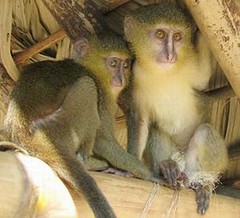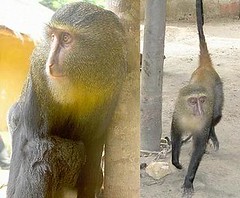 科學家在剛果民主共和國的偏遠森林中,發現了新種的猴子。這是28年以來,非洲第二次發現猴子的新物種。
科學家在剛果民主共和國的偏遠森林中,發現了新種的猴子。這是28年以來,非洲第二次發現猴子的新物種。
這種猴子當地居民與獵人稱為「勒蘇拉」(Lesula),現已正式命名為洛馬米長尾猴(Cercopithecus lomamiensis),屬於長尾猴族(Cercopithecini,包括非洲的長尾猴、侏儒長尾猴與綠猴等舊世界猴),該族中著名的種類有長尾猴(guenon)。
這種猴子的學名由其所棲息的洛馬米(Lomami)森林盆地來命名。一般認為,勒蘇拉長尾猴被只生活在剛果中央的成熟常綠森林內,界於Lomami盆地中部與Tshuapa河上游間面積17000平方公里(6,500平方哩)的區域。
這一發現12日發表在開放式取用期刊「PLos One」上。
第一隻勒蘇拉長尾猴是隻年輕的母猴,在2007年被發現圈養在奧帕拉鎮(Opala)一所學校董事的圍欄中。起初,科學家第一次看到該猴時,認為牠很像鴞面長尾猴(Hamlyn's monkey 或稱 owl faced monkey),但顏色又不同於任何其他已知的種類。
 在後來三年中,金夏沙(Kinshasa)Lukuru野生動物研究基金會(Lukuru Wildlife Research Foundation)生物學家,亦是本研究的作者John 與 Terese Hart與他們的團隊,尋找並觀察到更多野外與圈養的Lesula。
在後來三年中,金夏沙(Kinshasa)Lukuru野生動物研究基金會(Lukuru Wildlife Research Foundation)生物學家,亦是本研究的作者John 與 Terese Hart與他們的團隊,尋找並觀察到更多野外與圈養的Lesula。
在此之前,由於棲息地偏遠,該物種先前都未被科學家發現。
在第一次巧遇的圈養Lesula長尾猴後,Hart夫婦和他們的研究小組在野外觀察牠們,記錄其行為和生態習性,並透過遺傳與解剖學的研究,最終確定了牠的獨特性。
這些研究由耶魯大學人類學教授Eric Sargis與當時為耶魯大學生物圈研究學院博士後研究員、現為紐約市立大學(City University of New York)亨特學院(Hunter College)教授的Chris Gilbert,在美國皮巴迪(Peabody)所共同完成。
 其他作者有佛羅里達州大西洋大學的Kate Detwiler、紐約大學的Andrew Burrell與Anthony Tosi、哥倫比亞大學的James Fuller、Lukuru野生動物研究基金會的Maurice Emetshu以及森林保育中心(Centre de Formation et Conservation Forestière)的Ashley Vosper。
其他作者有佛羅里達州大西洋大學的Kate Detwiler、紐約大學的Andrew Burrell與Anthony Tosi、哥倫比亞大學的James Fuller、Lukuru野生動物研究基金會的Maurice Emetshu以及森林保育中心(Centre de Formation et Conservation Forestière)的Ashley Vosper。
鴞面長尾猴(Cercopithecus hamlyni)與勒蘇拉長尾猴的關係可能很近,但又彼此獨立。科學家表示,形態學和分子遺傳學的數據顯示,由於被Lualaba河(剛果河上游)和Lomami河的地理條件所隔離,使得Lesula長尾猴與其關係最親近的鴞面長尾猴有所不同。
典型勒蘇拉長尾猴面部與口鼻部裸露沒有毛髮,身上披有長且亮黃色帶有白班的長鬃毛,有些個體在鼻子上有奶油色的直條紋。主要取食水果與植物枝葉植,並會在地面與樹上活動。
 根據研究人員表示,另外尚有三個靈長類動物為這個區域特有的,分別為: Lomami河的紅疣猴(Procolobus foai, Red colobus)、Lomami河的藍長尾猴(Cercopithecus mitis, Blue monkey)與Kasuku河的鄔氏長尾猴(Cercopithecus wolfi, Wolf’s monkey)。
根據研究人員表示,另外尚有三個靈長類動物為這個區域特有的,分別為: Lomami河的紅疣猴(Procolobus foai, Red colobus)、Lomami河的藍長尾猴(Cercopithecus mitis, Blue monkey)與Kasuku河的鄔氏長尾猴(Cercopithecus wolfi, Wolf’s monkey)。
和所有存活在剛果的大型哺乳動物一樣,這些物種受到脫序的商業叢林肉狩獵(bush meat hunting)活動與棲息地喪失的威脅。
Scientists have discovered a new species of monkey in a remote forested part of the Democratic Republic of Congo, only the second new species of monkey to be found in Africa in the past 28 years.
Known to local residents and hunters as Lesula, the monkey has been formally named Cercopithecus Lomamiensis. The new species is a member of the tribe Cercopithecini, commonly known as guenons.
It was named for its habitat in the Lomami forest basin. The Lesula is believed to live only within 17,000 square kilometers (6,500 square miles) of mature evergreen forests in the central DCR, between the middle Lomami and upper Tshuapa rivers.
The discovery was made public today in a paper in the open-access journal “Plos One.”
The first Lesula found was a young captive female seen in 2007 in a school director’s compound in the town of Opala. At first, the captive Lesula appeared to the scientists as similar to the owl faced monkey, but its coloring was unlike that of any other known species.
Over the next three years, the study authors, conservation biologists John and Terese Hart of the Lukuru Wildlife Research Foundation in Kinshasa, and their team, located and observed more Lesula in the wild and in captive situations.
The species appears to have escaped previous scientific notice because of its remote habitat, until recently unexplored by professional biologists.
After their first coincidental encounter with the captive Lesula, the Harts and their research team observed it in the wild, documented its behavior and ecology, and conclusively determined its uniqueness through genetic and anatomical studies.
These studies were conducted at the Peabody by Sargis and co-author Chris Gilbert, then a post-doctoral fellow at the Yale Institute for Biospheric Studies and now a professor at Hunter College-CUNY.
Other authors of the paper are Kate Detwiler of Florida Atlantic University; Andrew Burrell and Anthony Tosi of New York University; James Fuller of Columbia University; Maurice Emetshu of the Lukuru Wildlife Research Foundation; and Ashley Vosper of the Centre de Formation et Conservation Forestière.
C. hamlyni may be closely related but is separate and distinct from the Lesula. The scientists write, “morphological and molecular data confirm that C. lomamiensis is distinct from its nearest congener, C. hamlyni, from which it is separated geographically by both the Congo (Lualaba) and the Lomami Rivers.”
The typical Lesula has a naked face and muzzle and a mane of long, grizzled blond hairs. Some have a cream-colored vertical nose stripe. The monkey appears to eat fruits and vegetation primarily, and to live both on the ground and in trees.
At least three other primates are found only in this region, according to the researchers – the Lomami River red colobus, the Lomami River blue monkey, and the Kasuku River Wolf’s monkey.
Like all of Congo’s remaining large mammals, these species are threatened by uncontrolled commercial bush meat hunting and habitat loss.
※ 全文及圖片詳見:ENS





